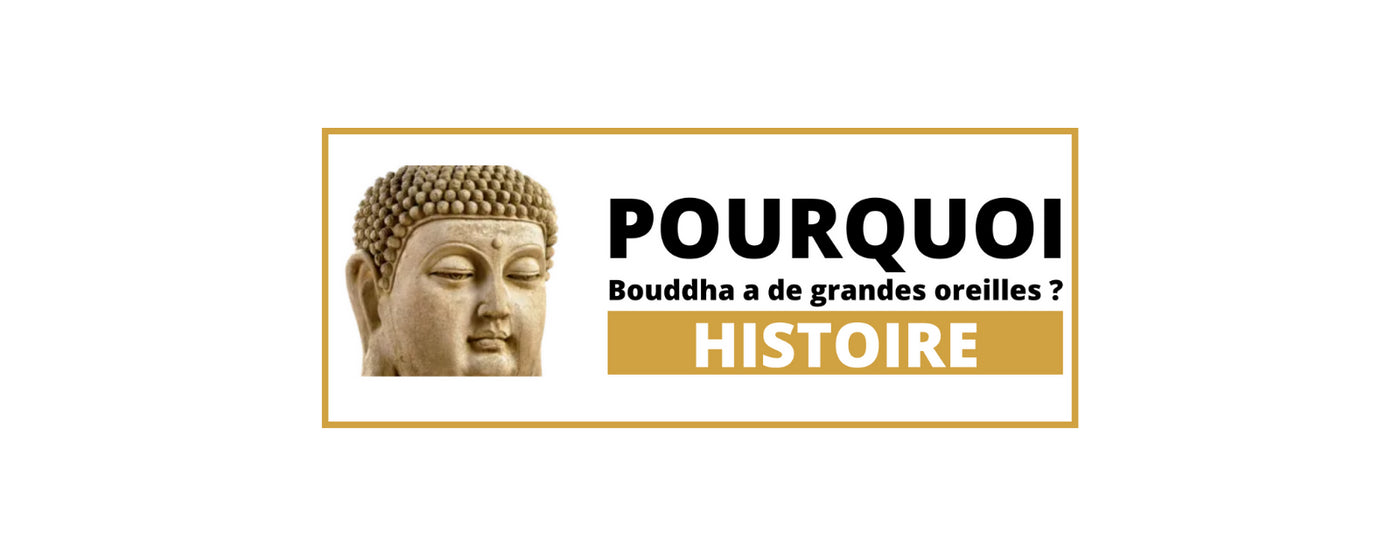Your Cart is Empty
🙏 La livraison est offerte sur tous vos achats ! 🙏

Statues of the historic Buddha can be found in almost all Buddhist temples. Usually, although they do not denote a "god," they are a strong symbol that reminds each believer of the path to follow. When you look at them, you get the impression that they are just a representation of Siddhartha Gautama! However, if we pay a little more attention, there are certain details that will catch our eye. : This is for example the case of the big ears of the Buddha.

Indeed, for those who do not know, the statues of the historical Buddha feature "huge" ears reminiscent of the shape of a Lotus. Why ? This is what we will see in this article by answering the question why does Buddha have big ears? As a bonus, we will tell you the meanings of this appearance in Buddhism and two other peculiarities of these statues.

The story of Buddha ears begins at a young age! Indeed, born in a small state in Japan, currently located in Nepal, Siddhartha Gautama was the crown prince to his father's throne. At least one of the suitors. As a wealthy man with a comfortable life, he, like everyone in his social class, tended to flaunt his wealth.

Usually, this involved luxury jewelry made of precious stones of all kinds, expensive clothes ... In other words, the historical Buddha in his youth adorned his body with all these valuable things. Among them, one can quote rather heavy earrings as is still the case in some countries of Asia, Africa and India.
The more time passed, the more the lobes of his ears began to grow due to the weight of his jewelry. However, this distortion was not obvious, as the beauty of the stones he wore partially obscured his ears. However, the situation will not be the same when Siddhartha Gautama (the historical Buddha) changes his life.

Once the Buddha found his new destiny, he decided to change his life by becoming an ascetic. For that, he had to relinquish all his privileges of the kingdom and follow the path of simplicity. In other words, he decided to cut his pretty hair long; to give up all the jewelry he wore; his clothes…
After his parting with his earrings, the historical Buddha had nothing left to hide his large earlobes. Become a simple ascetic wandering in a robe, everyone could then observe his big ears. However, while most people have an idea of what caused this, others were just surprised by the alien appearance.
As you might expect, the big ears of the historical Buddha have many meanings. Indeed, just like each of its postures, we interpret this in different contests.

In Buddhism, statues of Buddha with big ears are mainly considered a symbol of renunciation. Indeed, considering that having such lobes rhythms with jewelry and fortune; and that the Buddha did not have any more after his change, it is a sign of differentiation.
Differentiation in the case where it is displayed with bare ears, yet wide. Today, that is sort of the right path.In other words, knowing how to give up everything as a Buddha to attain nirvana
With the large ears of Buddha, he is also considered to be quite caring and attentive. Knowing that in Buddhism listening is a sign of wisdom, the large ears of Buddha make him quite wise.
Likewise, the importance of this distinction does not end there! Indeed, it is also credited with representing the generosity of this belief. In other words, the large buddha ears are a sign that Buddhism is opening its hands to everyone.

Besides the big buddha ears, other signs may also attract special attention. For example, why are there several Buddha statues in different positions? Or why is there a fat and a thin Buddha?
When it comes to the multiple statues of Siddhartha Gautama that can be seen in Buddhist temples, there is a simple explanation. Indeed, the positions of each of them represent a posture adopted by Buddha during his spiritual life.

In other words, they remind every Buddhist of the stages of the journey to awakening and sometimes of the skills to adopt depending on the circumstances. If you've never observed these differences, know that they most often relate to sitting, lying, standing; the position of the arms; those of the feet ... In addition, in certain representations, we note the expression of the gaze or the clothing.
Besides the big ears of Buddha, we can also talk about the body of the latter. Indeed, according to the temples, or even according to the country in which the temple is located, it is possible to observe two different Buddhas. One sometimes fat and smiling, and the other quite slim and serene!
As an explanation, it would be absurd to say that the two are equal! Therefore, we invite you to read our article which details this subject and gives you the origin of the big Buddha. As for the thin, it is none other than Siddhartha Gautama who has been talked about since the beginning of this text.Comments will be approved before showing up.